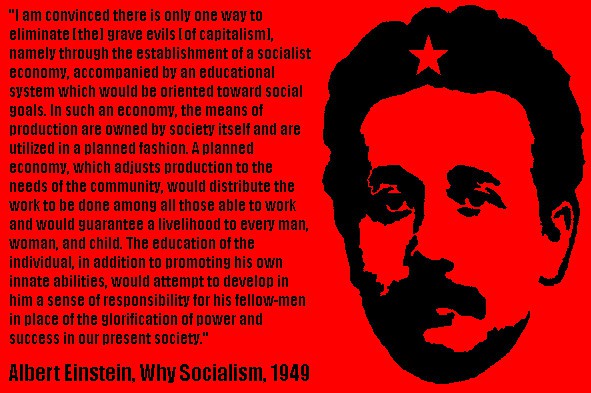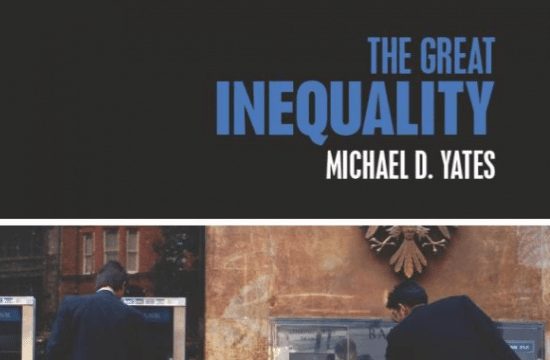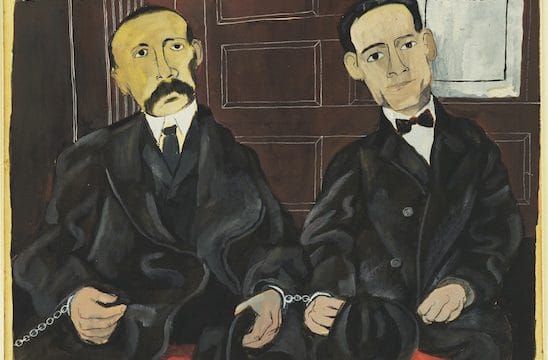 Right-wingers like Fox’s Bill O’Reilly are fond of saying that whites don’t have a monopoly on racism. Some black people hate whites, so they are racist too. Whites must stop being racist, but so must blacks. The implication of this way of thinking is that racism evens out in the end. It is seen as an individual defect, common to all of us.
Right-wingers like Fox’s Bill O’Reilly are fond of saying that whites don’t have a monopoly on racism. Some black people hate whites, so they are racist too. Whites must stop being racist, but so must blacks. The implication of this way of thinking is that racism evens out in the end. It is seen as an individual defect, common to all of us.
The problem with this way of perceiving racism is that it ignores the larger social structures in which individual attitudes are shaped. In his book, Inequality and Power: The Economics of Class, economist Eric Schutz suggests that as we make individual choices about all sorts of things, we, at the same time, make “social choices.” These structure the larger society, which, in turn, conditions our individual decisions. Our political system is a case in point. The United States was founded as a nation whose prosperity depended heavily upon slavery, which was the dominant mode of production in the southern states and tightly integrated into northern capitalism. The slave trade, the production of important commodities such as cotton and tobacco, the textile industry, shipping, construction, the manufacture of agricultural implements, and many other economic activities were intimately tied to slavery.
The slave economy was supported by a constellation of laws that maintained the entire oppressive system. Who enacted these laws? That is, were the “social choices” that allowed, defended, and maintained slavery made by everyone equally or were the choices of some weighted more heavily than those of others? It would take someone more obtuse even than Mr. O’Reilly to argue that in 1789 there was political equality in the United States. Slaves had no political power, and even among those who were not slaves, women could not vote, and, in many states, whites had to own property to cast a ballot. Blacks in the north were nominally free but subject to extreme race and class discrimination. So politics was dominated by white, male property owners, who shaped the government decisively to serve their interests, including the institution of slavery. And by the time slavery ended, inequalities of income and wealth had developed to the point that this white, male, economically elite power was thoroughly entrenched and difficult to unseat. So what this elite wrought was also hard to change. Slavery ended, but the institutional setting in which it flourished did not.
Consider the conditions of black America at the end of the Civil War and especially after the end of Reconstruction in 1876. The slaves were freed but given no property, not even small plots of land so that they could feed their families. Without wealth or income, they had to fend for themselves. Federal soldiers protected them to a degree, but when the troops left, they fell victim once again to their white masters, who regained control of southern state governments and passed the Jim Crow laws that created a system of apartheid that dominated the south for nearly one hundred years. These states gave full sanction to white vigilantism, which stood ready to murder blacks who refused to succumb to white rule. Blacks were being lynched by white mobs into the 1960s. Through new laws that criminalized everyday activities, the white rulers of the south filled up the prisons with black men and women, and then contracted them out to white business owners, creating what a recent PBS documentary called “slavery by another name.”
If a group of people begin life with little income and no wealth, they are not likely to fare well economically. Modern research on economic mobility teaches us that it is not nearly as great in the land of opportunity as most people think. What matters most is how well-off your parents are, mainly how much wealth they have. The children of poor parents are a lot less likely to end up rich than those whose parents are rich. Perhaps as much as 60 percent of the parents’ income advantage is passed along to their children. This means that a person’s great-great-grandparents’ wealth confers an advantage upon him or her today. By the same token, the poverty of your great-great–grandparents will haunt you now. Compound this inter-generational income and wealth effect with the impact of slavery and the “social choices” that whites made, nearly all of which created a society in which former slaves and their progeny were marginalized and considered barely human. Here is how I put it in something I once wrote:
Imagine my own great-great-grandfather and suppose he had been a black slave in Mississippi. He would have been denied education, had his family destroyed, been worked nearly to death, suffered severe privation during the Civil War, and been considered less than human. Then in 1865 he would have been “freed,” to fend for himself and whatever family he had. No job, no land, no schools, no nothing. For twelve short years, he might have had some protection provided by the federal government against the murderous rage of white Southerners. But in 1877 even that ended, and afterward he would have been confronted with the full force of Jim Crow and the Ku Klux Klan. What chance would his children have had? How likely would they have been to catch up with their white overlords? Isn’t zero the most likely probability? His grandchildren might have migrated north, but again with no wealth and not much schooling. His great-grandchildren would have lived through the Great Depression. How much property would they have been likely to accumulate? Finally, through the heroic struggle of my ancestors and my own generation, I would have seen the victories of the civil rights movement, the desegregation of the schools, the end of lynchings, and the opening up of a few decent jobs. I might have been an auto worker in Detroit for a dozen years, but then in the 1970s everything would have come crashing down again.
Let’s return to the argument that both blacks and whites are, to one degree or another, racist. If this is so, then, other things equal, the respective racisms should more or less cancel out, and no particular social outcomes would be expected to occur as a consequence of racism. That is, race wouldn’t enter into the social choices Schutz writes about.
Can we put this notion of black racism and white racism canceling out to the test? Let’s look at data that describe certain important economic and social outcomes: income, wealth, jobs, poverty, unemployment, housing, life expectancy, infant mortality, and imprisonment:
1. Income: In 1947, the ratio of median black family income to white family income was 51.1 percent. In 2009, it was 61.4 percent. After the heroic struggles of the Civil Rights Movement and the enactment of numerous civil rights laws, this seems a small gain, barely higher than the 59.2 percent of 1967.
2. Wealth: When we have assets, we have some security against unforeseen problems such as illness; assets can be sold and some of them generate income. In 2009, the median net worth (all assets, including homes, minus all debts) of black households (a household is not necessarily a family) was $2,200, while for whites it was $97,900. Black median wealth was 2 percent that of whites. If we confine our data to median net financial wealth (assets include mutual funds, trusts, retirement and pension funds, etc.), black households had $200, while whites had $36,100, for a ratio of black to white of .0056. I always do a double take when I see these numbers. Nearly twice as many black households as white had zero or negative net worth (39.2 versus 20.3 percent).
3. Wages and Jobs: Black workers earn less than their white counterparts; black men, for example, earn less that three-quarters the wages of white men. The black-white earnings ratio is less than one for every level of schooling. Part of this is due to the fact that blacks, no matter their level of schooling, are over represented in jobs with relatively low wages and under represented in higher-paying jobs. A report from the Economic Policy Institute tells us that “The average of the annual wages of occupations in which black men are overrepresented is $37,005, compared with $50,333 in occupations in which they are underrepresented.” Further, “A $10,000 increase in the average annual wage of an occupation is associated with a seven percentage point decrease in the proportion of black men in that occupation.” Another part of the reason for the relatively low wages of blacks is that they earn less money within the same occupations. A summary of data collected by the Bureau of Labor Statistics shows that “In 2010, median usual weekly earnings of . . . White men ($1,273) working full time in management, professional, and related occupations (the highest paying major occupation group) were well above the earnings of Black men ($957) in the same occupation group.” For women, the numbers were $932 for whites and $812 for blacks. Racial wage discrepancies exist in every occupational category. If instead of specific occupations, we look just at low wage work, we find racial disparities. About one-quarter of all jobs in the United States pay a wage that, for full-time, year-round work, would put a family of four below the poverty level of income. But for jobs held by black workers, this figure is nearly 35 percent.
4. Poverty: The United States officially defines the poverty level of income as the cost of the Department of Agriculture’s minimum food budget times three. It is a bare bones income, equal in 2010 to $22,491 (before taxes) for a family of four. In 2010, 46.2 million people lived in poverty, giving a poverty rate of 15.1 percent. This dreadful number, the highest in any rich capitalist nation, masked large differences by race. For non-Hispanic whites, the rate was 9.9 percent; for blacks it was 27.4 percent. 13.5 percent of blacks lived at less than one-half of the poverty level of income. For black children (less than eighteen), the incidence of poverty was 39.1 percent.
5. Unemployment: The official unemployment rate has almost always been about twice as high for blacks as for whites. Last month, these rates were 13.6 and 7.4 respectively. Double-digit unemployment rates are more common than not for black workers, a condition that would be unacceptable if it were true for white workers. Other labor market statistics, such as the underemployment rate (which includes involuntary part-time workers and those who want work but have given up looking), the employment rate (employment divided by noninstitutional population at least sixteen years of age) and the labor force participation rate (the labor force divided by the noninstitutional population at least sixteen years of age), all show racial disparities. In 2011, the underemployment rate was 13 percent for whites and nearly 25 percent for blacks.
6. Housing: Homes are the most important form of wealth for most households. Not unexpectedly, there is a racial gap here too. Whites are 25 percent more likely to own homes than blacks. In addition, the current meltdown in housing prices has disproportionately hurt black homeowners. In connection with housing, it is useful to mention the recent study by the Manhattan Institute, which has received a great deal of media attention, that housing segregation has dramatically declined. The authors use a “dissimilarity index” as a measure of segregation and show that this has fallen. An Economic Policy Institute (EPI) evaluation of the study explains: “They find a national dissimilarity (or segregation) rate of about 55 percent for African Americans—in other words, ‘only’ 55 percent of African Americans would now have to move to neighborhoods with more non-blacks in order to evenly distribute the black population throughout all neighborhoods in their metropolitan areas. This is a substantial decline from the segregation level of about 80 percent in 1970.” Against the optimistic gloss that has been put on the Manhattan Institute analysis, the EPI authors make several salient points. First, a 55 percent segregation rate is nothing to brag about, and it will rise now that black homeowners in white neighborhoods have been experiencing so many foreclosures. Second, the dissimilarity index is a somewhat indirect measure of black and white interaction. By another measure, the typical black person lived in a neighborhood that was 40 percent white in 1940; today this has fallen to 35 percent. And even for the dissimilarity index, some of the decline is due to an influx of Asians and Hispanics into black localities, while another part of it is the consequence of the greater economic mobility of the black middle class. Poor blacks have been left behind, stuck in almost totally segregated areas, without jobs as manufacturing left town, and unable to follow jobs to the suburbs. The “high poverty” neighborhoods are home to 40 percent of all poor blacks (only 15 percent of poor whites live in such neighborhoods).
7. Life Expectancies and Infant Mortality: There is no reason to expect that, other things equal, one group of people in a country should exhibit different life expectancies and infant mortality rates than another. In 2010, blacks could expect to live four years less than whites. Infant mortality rates are more than double for black than for white women. Perhaps one reason for this gap is that blacks are nearly twice as likely as whites to have no health insurance.
8. Prisons and the Criminal Justice System: Here the racial divide is startling. Michelle Alexander calls what has happened to blacks here “mass incarceration,” which functions much like Jim Crow: a “tightly networked system of laws, policies, customs, and institutions that operate collectively to ensure the subordinate status [of black Americans].” In 2010, 2,226,800 persons were incarcerated in the United States, and another 4,887, 900 were either on probation or parole. So, the United States has a criminal justice system population of over seven million people. Nearly 40 percent of this population is black; more than triple the black share of the U.S. population. At every step in the criminal justice system—arrest, arraignment, legal representation, plea bargaining, jury selection, verdict, sentencing, chance for parole, prospects after imprisonment—blacks fare worse than whites.
All of these things would lead us to reject the hypothesis that white and black racism offset one another. What is more, we would get the same results even if we conducted more sophisticated tests of this hypothesis. For example, black wages are lower than those for whites even if we factor out schooling, age, occupation, industry, experience, region of the country, and whatever else we think influences wages. That is, if we look at two groups of workers equal in all respects (same schooling, experience, etc.), the black group will have a lower average wage than the white group. The same result would hold for whatever variable we considered—prison sentences, unemployment, life expectancies, and all the others mentioned above.
We are left with an inescapable conclusion. Having a black skin, in and of itself, is a grave economic and social disadvantage, while having a white skin confers considerable advantage. That this is true today, 146 years after the end of the Civil War, after three constitutional amendments, the great civil rights movement, a large number of civil rights laws, and lord knows how many college courses and sensitivity training sessions is testament to the power and tenacity of discriminatory social structures.
What might be done about black-white inequality? Some left-wing writers have argued that race-conscious remedies, such as affirmative action, are bound to be divisive and should be abandoned in favor of class-based relief. Some people I know objected strongly when a friend of mine suggested that anyone serious about racial disparities should campaign for the abolition of our prison system. While these persons knew that prisons are a key component of our discriminatory social structures, “abolish the prison system” would surely be an extremely unpopular plank in a radical movement’s platform. It would have no chance and would just alienate whites and quite a few blacks from our cause. Better to fight for something like full employment through a public jobs program. This would have a wide appeal, and while it is race neutral, it would have a greater impact on black workers since they have much higher unemployment rates. A similar logic can be applied to national health insurance or low-cost public housing. The ideas is to fight for things that unite the working class.
The “unify the working class” strategy doesn’t seem quite right to me. If it is true that the social choices made since the beginning of the United States have created racist social structures and if these have yet to be eradicated, it makes sense to have as part of a radical program a direct confrontation with these structures. If we had a full employment jobs program, how would it eliminate the gap between black and white wages, unless at the same time it was aimed disproportionately at black workers? If we don’t aim to guarantee that blacks become leaders in our movements, then how will a full employment program or national healthcare or public housing be implemented so that they do not disproportionately benefit whites, who after all, hold the most leadership positions in all movements, radical and not. Even if we were to make every element of the criminal justice system nondiscriminatory, how could we make sure that the enormous number of black men and women enmeshed in this system now will be able to extricate themselves from it and become full and equal citizens, unless we have race-specific programs to help them?
Given the extent and depth of white privilege, racial issues have to be addressed and attacked head on. There is no easy way out. The working class will never be unified unless we once and for all confront the institutional racism that surrounds us. Unity requires restitution for past and present damages. Nothing less will do.








i come over here and read this
by the end i’m in fuck knots
we have to attack together
but yes targets can not be chosen
on a class basis alone
how to concentrate the black national struggle today
free all prisoners
is a fine working slogan
ya it’s a massively blunt instrument
but directed at exactly the correct target
—the board and the wack
that gets uncle jack ass’s attention —
Paine, an honor to have you visit. Come again any time. Every white leftist ought to visit a prison at least once, and then maybe each would say that at least some effort ought to be directed at ending the prison system.
MY:
Black nation think may notbepart of your thinker gig
But a term useful to me when operating from behind the Paine nationalities desk
Is
Helot Nations
Black America
A Stateless sympatric “brother ” Nation
under the yoke of one mother of a Cain brother
The white nation with it’s white state
That we are all citizens of the white state
Hardly makes the white state the black nation’s state
Nope it’s an occupation state
One nation’s means
–among other uses–
To oppress another
As such radically illegitimate
But that since the mid 60’s is a de facto reality
Citizen state ?
What a hog wash
What a white wash
I concur with all your conclusions Michael, especially given the figures of circa 55.9% unemployment rate amongst Black youth in the UK just announced this week too..The imbalances you refer to would as easily translate similarly to aborigines in Australia and Maori/Pacific Islanders in Aotearoa NZ where I reside now.. thankyouhttp://www.guardian.co.uk/society/2012/mar/09/half-uk-young-black-men-unemployed
Jax, thanks for the comment and the link. Discrimination against racial and ethnic minorities is a worldwide phenomenon with a long and inglorious history.
It’s the bosses we need to fight, not each other!
One race, one fight, workers of the world unite! You have nothing to lose but your bosses. You have the collective product of your labour to gain. Abolish wage-slavery…over and out.
The enemy is not the black man white man hispanic asian or any other man; his name is the devil and he comes not but for to steal kill and destroy. The battles above are real issues but they are being fought on the wrong battlefield. You will never defeat the enemy you don’t know or that you deny exists.. people in the world have been fed information for YEARS to get us further away from our creative exsistence of peace- event by event, rule by rule,program by program to leave roots of bitterness toward the wrong thing. As a child of God, I’m exempt from the statistics, disadvantages and so called rules of this world simply because I don’t look at circumstances and situations to define me..I look to God. Thoughts are the problem- an electrical impulse that runs from neuron to neuron will have you act like a moron over the wrong thing.. someone will get this one day. But hey “keep the struggle alive” you’re helping yourself defeat yourself.